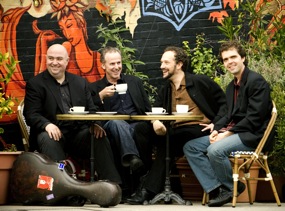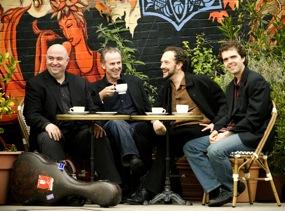
Featured Video
Related Article
For Guitarists, the Bay Area is Heavenly
November 9, 2010
If you are unfamiliar with the Grammy Award–winning Los Angeles Guitar Quartet, here is a clever way to make their acquaintance.
In this bravura, six-minute You Tube performance, the quartet’s members — William Kanengiser, John Dearman, Matthew Greif, and Scott Tennant — take a decidedly Loose Canon approach to Pachelbel’s classic, one that begins in reverence and then slices, dices, and splices the old chestnut into a kaleidoscope of stylistic variations, from Latin, jazz, and bluegrass to Cream-style rock ’n’ roll. It’s a virtuoso deconstruction that may upset a few purists, but one that offers a brilliant example of LAGQ’s technical artistry and willingness to embrace the full range of the guitar’s repertory.
San Francisco Performances will present the Los Angeles Guitar Quartet in a Jan. 15 recital at Herbst Theatre. The program (which may or may not include Pachelbel’s Loose Canon as an encore) will begin and end operatically, with arrangements of Rossini’s Overture to The Barber of Seville and six excerpts from Bizet’s Carmen. In between, the recital will feature a transcription of Peter Warlock’s Capriol Suite; a contemporary composition by Leo Brouwer, called Cuban Landscape With Rain; and the Antique Suite by Ian Krause, based on lute music of the German Renaissance.
LAGQ’s roots date back to the 1970s — a time, says founding member Kanengiser, when the music department of the University of Southern California was a Mecca for aspiring young guitarists.
“The reason we all met in L.A. was because Pepe Romero was teaching at USC,” Kanengiser explains. “He was like a magnet that drew some of the top guitarists in the world, including competition winners and members of other ensembles. Jim Smith [who headed the department for 35 years and recently died] and Ian Krause [who founded the de Falla Guitar Trio] were also there.”
It was the Romero family, led by its patriarch, Pepe Romero, who popularized the guitar quartet. Before their arrangements, says Kanengiser, the form barely existed, since nearly all quartets were composed for ensembles featuring a family or choir of instruments with hierarchical tuning.
“The Romeros really created the form and made it mainstream,” says Kanengiser. “They played on the Ed Sullivan Show. They played at the White House and for the pope. They also got composers like Torroba and Rodrigo to compose pieces for them [such as Rodrigo’s 1965 Concierto Andaluz, which is featured on LAGQ’s current Grammy Award–nominated Telarc CD].”
Now, Kanengiser points out, if you look at published guitar music you’ll find hundreds of pieces for guitar quartet, nearly all composed since the 1960s.
“The challenge is that we play four essentially identical instruments. And while you might think that would create too much homogeneity, instead it makes each instrument an equal partner. We are constantly sharing and passing ideas around — no one plays second fiddle. Our goal is to see how many different colors, sounds, and timbres we can create.”
Since its start in 1980, the LAGQ has explored and developed a repertory that includes the widest possible range of influences: from lute styling of the German Renaissance and the flair of Spanish flamenco to the earthiness of American bluegrass and even the tintinnabulation of a Javanese gamelan.
“Some styles seem natural, particularly Spanish, Latin, and Renaissance music,” says Kanengiser. “About two thirds of our San Francisco program is inspired by Renaissance music. The obvious restriction is the guitar’s inability to create long sustained notes, so a piece like Barber’s Adagio for Strings would be a bad choice. Through a process of trial and error, we’ve discovered what fits best. People may think some of our choices are calculated marketing decisions, but all the styles we play are based on music we love, whether it’s classical, jazz, bluegrass, or rock. Hey, when I was a kid I wanted to be a rock ’n’ roll guitar god!”

